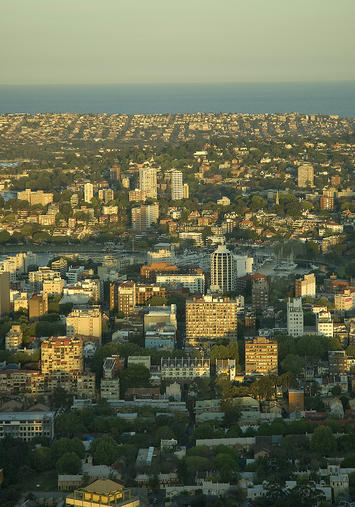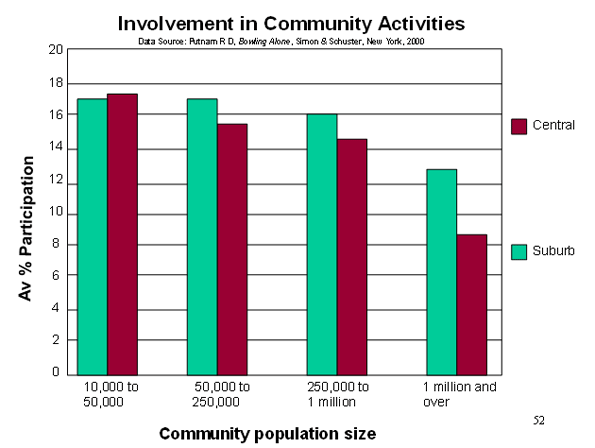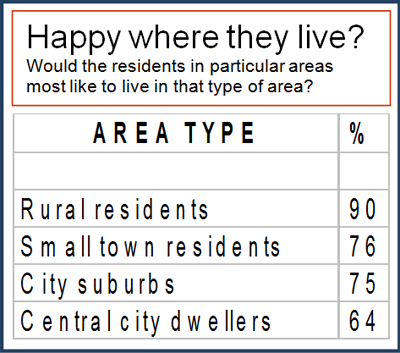
The proponents of currently fashionable planning doctrines favouring density promulgate a variety of baseless assertions to support their beliefs. These doctrines, which they group under the label of “Smart Growth”, claim, among other things, that from a health and sustainability perspective, the need to increase population densities is imperative.
With regard to health these high-density advocates have seized upon the obesity epidemic as a reason to advocate squeezing the population into high-density. This is based on a supposition that living in higher densities promotes greater physical activity and thus lower levels of obesity. They quote studies that show associations between suburban living and higher weight with its adverse health implications. But the weight differences found are minor – in the region of 1 to 3 pounds. Nor do the studies show it is suburban living that has caused this.
The suburbs, after all, have been with us for 70 years and reached its mature development over 40 years ago. Obesity, on the other hand, is a much more recent phenomenon and is primarily due to people eating too much fattening food.
Less discussed, however, are other facets to human health and it is important to consider the results of research on the association with high-density living of mental illness, children’s health, respiratory disease, heart attacks, cancer and human happiness.
A significant health issue relates to the scourge of Mental Illness. There is convincing evidence showing adverse mental health consequences from increasing density.
A monumental Swedish study of over four million Swedes examined whether a high level of urbanisation (which correlates with density) is associated with an increased risk of developing psychosis and depression. Adjustments were made to cater for individual demographic and socio-economic characteristics. It was found that the rates for psychosis (such as the major brain disorder schizophrenia) were 70% greater for the denser areas. There was also a 16% greater risk of developing depression. The paper discusses various reasons for this finding but the conclusion states: "A high level of urbanisation is associated with increased risk of psychosis and depression".
Another analysis, in the prestigious journal Nature, discusses urban neural social stress. It states that the incidence of schizophrenia is twice as high in cities. Brain area activity differences associated with urbanisation have been found. There is evidence of a dose-response relationship that probably reflects causation.
There are adverse mental (and other) health consequences resulting from an absence of green space. After allowing for demographic and socio-economic characteristics, a study of three hundred and fifty thousand people in Holland found that the prevalence of depression and anxiety was significantly greater for those living in areas with only 10% green space in their surroundings compared to those with 90% green space.
High-density advocates seem most oblivious to the needs of children. Living in high-density restricts children’s physical activity, independent mobility and active play. Many studies find that child development, mental health and physical health are affected. They also find a likely association of high-rise living with behavioural problems.
An Australian study of bringing up young children in apartments emphasizes resulting activities that are sedentary. It notes there is a lack of safe active play space outside the home – many parks and other public open spaces offer poor security. Frustrated young children falling out of apartment windows can be a tragic consequence. Children enter school with poorly developed social and motor skills. Girls living in high-rise buildings are prone to increased levels of overweight and obesity.
A British study found that 93% of children living in centrally located high-rise flats had behavioural problems and that this percentage was higher than for children living
in lower density dwellings. Anti-social behaviour often results. An Austrian study showed disturbances in classroom behaviour higher for children living in multiple-dwelling units compared to those living in lower densities.
There is also evidence of other potential health impacts on children living in higher density housing. These include short-sightedness due to restricted length of vision, and diminished auditory discrimination and reading ability due to exposure to noise.
Air pollution increases with density. This results from higher traffic densities together with less volume of air being available for dilution and dispersion. Nitrogen oxides in this pollution have adverse respiratory effects including airway inflammation in healthy people and increased respiratory symptoms in people with asthma. There is consistent evidence that proximity to busy roads, high traffic density and increased exposure to pollution are linked to a range of respiratory conditions. These can range from severe conditions (such as a higher incidence of death) to minor irritations. Moreover, these respiratory health impacts affect all age groups.
Several studies relate low birth weight to air pollution. A South Korean report, for example, found the pollutants carbon monoxide, nitrogen dioxide, sulfur dioxide, and total suspended particle concentrations in the first trimester of pregnancy pose significant risk factors for low birth weight.
Air pollution particulates are associated with killing more people than traffic accidents. Pollutants such as those emitted by vehicles are significantly associated with an increase in the risk of heart attacks and early death.
Cancer is a major health scourge and a relationship between increased colon cancer, breast cancer and total cancer mortality with population density has been found.
There is an association between overall Human Happiness and density. Professor Cummins’ Australian Unity Wellbeing Index reports that the happiest electorates have a lower population density. A United States study finds the satisfaction of older adults living in higher density social housing reduces as building height increases and as the number of units increases. By contrast, in lower densities there are higher friendship scores, greater housing satisfaction, and more active participation. This does not apply only to single family houses: Residents of garden apartments have a greater sense of community than residents of high-rise dwellings.
An example of misinformation on this issue can be found in R.D. Putnam’s famous book “Bowling Alone”. Putnam states that "suburbanisation, commuting and sprawl" have contributed to the decline in social engagement and social capital. However I have shown that data from charts in his book indicate quite the opposite:

Adapted from Figure 50, Putnam R D, Bowling Alone, Simon & Schuster, New York, 2000
This shows that involvement in these social activities are more common in the suburbs than in the denser centres of cities (and that they become more common as the community size and density decreases).
Community contentment relating to the density of surroundings is revealed by a study in New Zealand that asked people if the type of area they would most prefer to live in is similar to the area they currently live in. The responses are shown in this table.

So 90% of rural residents would prefer an area similar to their current area but only 64% of central city dwellers would prefer an area similar to their current surroundings. It can be seen that satisfaction decreases as density increases.
Thus evidence from a variety of sources points to greater human happiness and better health in lower densities --- the exact opposite of the theories of the advocates for “cramming” people into ever small places.
(Dr) Tony Recsei has a background in chemistry and is an environmental consultant. Since retiring he has taken an interest in community affairs and is president of the Save Our Suburbs community group which opposes over-development forced onto communities by the New South Wales State Government.
Sydney suburb photo by BigStockPhoto.com.













Health density
Health is a primary term that provides multiple facilities to the people and helps to provide best support to maintain a good health. In most of the urban regions; we have found that medical organizations were providing best health support to the people with reasonable cost. Otherwise they are suffering from lack of perfect health care facilities; so especially in urban sector or high density regions health care is the first priority.
immediate medical care Hattiesburg, MS
artist's impression
I don't have any statistics, just a personal pov. High density is the enemy of everything of value that is hard to quantify, noticed only by its absence: privacy, quiet, not having to hear your thoughts over the noise of TVs on surround sound.
The push to change public opinion on apartment living reminds me of those posters captioned 'artist's impression'. It might be high rise blocks enclosing a charming communal park, or a new style train carriage -- always showing a contented parent with pram and a well behaved child alongside, plus a tasteful sprinkling of placid adults dotted at civilized intervals. The reality will be people treading on each others frayed nerves, hating each other with the ferocity of sociopathic rats trapped in their overcrowded overfed rodent utopia.
Shared walls are a nightmare, as are ceilings that are also floors -- where your upstairs neighbours occupy themselves with what sounds like rolling and stomping on walnuts nightly from 2am to sunrise. You need to be quite deaf (as many are these days) to tolerate this.
Think of your worst holiday hotel experience, only for much much longer.
People in egg cartons
How stupid can politicians get to have humans in "cages", eating free range eggs? Why bother with organic or free range, when we ourselves will be couped up in little matchboxes.
So that it becomes more profitable for overseas investors? or SMSFs? or increased government revenue via stamp duty? easier to control population in confined physical and mental space?
In crime and health hotspots all over the world people live in high rise units locked in and isolated, while those in low density housing tend to be more healthy, community minded and social with others.
Over 60% of new dwellings hig-hrise developments in NSW
Over 60% of new dwelling approvals are now high density developments in NSW (Australia) and this will grow with over 1.5 million immigrants coming to Sydney to live in the next few years. Most of the new high rise developments will not have appropriate usable open space or suitable amenities for families, who will have little option but to live in a high rise units if no other options such as villas, townhouses are built etc.
Many of Sydney's inner and middle ring suburbs where the increased densities are going were not planned for increasing populations and do not have sufficient open space and parkland for current populations let alone for thousands more.
The NSW government and the planning department in particular does not appear to be concerned about social and health impacts of urban consolidation. Planners seem more concerned about financial viability for the development industry than people's health and well being.
high density advocates ignore the evidence
Unfortunately high density advocates ignore the evidence in favour of their preconceived notions of what people should like.
Nobody should still be referencing Putnam, but they do
Interestingly, Joshua D. Gottlieb and Edward L. Glaeser in "Urban Resurgence and the Consumer City" (2006), showed something similar about Putnam's data.
“……..while density is correlated with consumer amenities, we show that it is not correlated with social capital and that there is no evidence that sprawl has hurt civic engagement……
“…….The problem with Putnam’s logic (“Bowling Alone”, 2000) is that sprawl is not responsible for longer commutes and that, in fact, commutes are actually shorter in low-density metropolitan areas. Lower density, sprawling areas are not associated with longer commutes, rather they are associated with shorter commutes. As such, it shouldn’t surprise us that these places have more social capital. The longer commutes in dense places discussed in section II should deter social engagement. While high-density living is certainly a plus for many forms of social connection, civic associations do not seem to thrive in higher density areas. Within metropolitan areas, there is no connection between central city residence and most forms of social capital. Across metropolitan areas, density is associated with less, not more social capital, perhaps in part because density is associated with longer commutes. Sprawl may have negative consequences along other dimensions, but it cannot be credited with killing social capital…..”
Another paper:
"Social Interaction and Urban Sprawl", Jan K. Brueckner and Ann G. Largey (2006)
Conclusion
"Various authors, most notably Putnam (2000), have argued that low-density living reduces social interaction, and this argument has been used to buttress criticisms of urban sprawl……
…….The key element in this argument is a positive link between social interaction and neighbourhood density, and our paper tests empirically for such a link. The results are unfavorable: whether the focus is friendship-oriented social interaction or measures of group involvement, the empirical results show a negative, rather than positive, effect of density on interaction.
The paper’s findings therefore imply that social-interaction effects cannot be credibly included in the panoply of criticisms directed toward urban sprawl. In fact, the results suggest an opposite line of argument. With a negative effect of density on interaction, individual space consumption would tend to be too low rather than too high, tending to make cities inefficiently compact...."
But the growth containment advocates and urban planners remain impervious to objective research; they need sorting out just as badly as the IPCC does, and are just as wrong and intransigent.
Research says that people
Research says that people belongs from higher density areas are always getting beneficial supportive programs under health care and other care services. In urban areas we have found better care opportunities and beneficial source to repair our health care problems. Therefore we must say that people belongs from higher density are always getting suitable health care opportunities.
urgent care wait times
Happinesss
The responses are shown in this table. ???
http://www.airfelklimaservisi.biz.tr/
http://www.baymakkombiservisin.biz.tr
http://www.ecakombiservisin.biz.tr